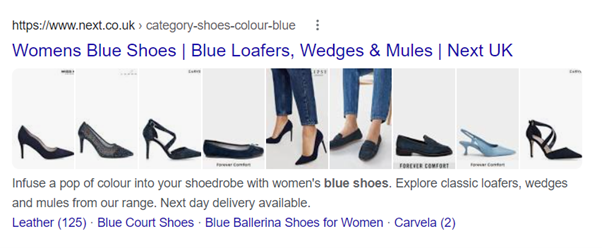Writing for ecommerce and writing for SEO have often been seen as two very conflicting disciplines in the past. Ecommerce lends itself to snappy and pithy sales copy that will help convince people to buy a product, whereas SEO-driven copy has a requirement for quantity as well as quality, and a necessary focus on search terms that people use to find whatever it is that you sell.
As a brand that sells online, you don’t want the content to get in the way of your slick visuals and a smooth UX, but attracting the right kind of traffic to your product pages is also a must. Can you really please savvy shoppers at the same time as search engines?
We think so! It’s a matter of finding the right balance and using SEO best-practice, combined with a good understanding of your audience, product knowledge and what makes a good user experience, to craft the right kind of ecommerce SEO content that gets results on all fronts.
We’ve compiled some of our top tips to help you find the right balance on your ecommerce website.
1. Take a fresh look at your keyword strategy before creating any new content
When you’re looking at SEO for product pages specifically, it’s vital to consider the intent of searchers, rather than just choosing keywords to target that have the biggest monthly average search volumes. Driving 50 visitors who demonstrate purchase intent through their search to a page on your website can be so much more meaningful to your business than driving 5,000 visitors who are never likely to buy from you.
Find out more about intent-led keyword research for ecommerce.
2. Plan your ecommerce content to be customer-centric
Search engines are designed to return the best possible information to searchers; that’s why people use them after all. So, ensuring that your ecommerce content is focused around providing the answers and information that customers need is always the right approach.
- Why will your product solve their problem or meet their need?
- What questions might your customers have about this product before they commit to buy?
By ensuring that you provide them with the information they need to be confident making a purchase decision, you can help get the transaction over the line. Approaching things from the customer’s point of view can feel very different to starting with your product and working outwards, but it can make a real difference to the type of traffic that you attract.
3. Use your keywords wisely
We’ve all seen keyword stuffing and know that not only does it make for a pretty poor user experience, it also doesn’t work from an SEO point of view anymore either. Your focus keywords very much need to be included on a page, but you absolutely don’t need to hit a certain number of occurrences or density. Rather than trying to shoehorn keywords into an ecommerce page, utilise your page title, meta description, H1 and the other header tags to incorporate keywords whenever possible. This can help to ensure that your main copy on the page is more concerned with delivering the information that customers need to know rather than being a vehicle to get your target keywords into the content – better for sales and a more straightforward experience for the user.
4. Create unique product description copy
If you want to help keep product pages clean, tidy and uncluttered, taking advantage of every opportunity to use unique optimised content is important to make the most of your SEO potential. This is why every snippet of generic or manufacturer-provided product information that you use on your ecommerce site is a wasted chance for you to stand out from everyone else selling similar products, both to potential customers and search engines. Replacing generic product information with your own useful and unique copy is an easy win from an SEO point of view – it helps give search engines a decision to make about which pages to rank for relevant search terms.
5. Shape your SERP listings as best as you can
While the search engines themselves will always have the ultimate control over how they display search results, there are elements that can help you shape the way your ecommerce site appears in results listings to a significant degree. These include:
- Your page title tag
- Your meta description
- Schema markup implemented on the page
By utilising certain types of Schema markup on a category page, for example, you can deliver a search result that gives shoppers a more compelling reason to click through. Searching for ‘blue shoes’ brings up the below result from brand Next. They have utilised ItemList Schema to highlight the types of blue shoes that they sell within the search result itself, showing Leather, Court Shoes, Ballerina Shoes etc right there in the SERP, showing the customer more information about what’s available.
You can also add product structured data to product pages to help provide the search engines with more information they can use in their listings.
Google won’t always use your chosen page description, the search engine sometimes rewrites these, but you can give your pages the best chance of appearing as you wish in search results by sticking to the best practice guidelines i.e. stick to a page description of 156 characters or less and give people a reason to click through.
6. Ensure your ecommerce content is clear and concise
There is no ‘perfect’ amount of content to have on an ecommerce page when it comes to SEO. The most important thing is to provide the text information that your potential customers will find most useful. A general rule of thumb is that around 300 words of content on category and product pages is optimum, but quality is far more important than quantity. Keeping your ecommerce copy concise can be tricky if you have a lot of information to get across, but it’s better for people and search engines if you try to:
- Use short sentences and paragraphs
- Breaking up longer sections (or features/benefits) with bullet points or lists whenever possible
- Use internal links within content to show customers relevant categories/products they might find useful as well as any appropriate guides, blogs or FAQs
- Split the content up if needed e.g. to stop your ecommerce page copy from pushing products below the fold, you can add approx. 100 words above the products and the rest at the bottom of the page
While finding the right balance can sometimes feel like a challenge, SEO content and compelling sales copy don’t have to be in conflict and can share the same space. With the right research, planning and implementation, you can increase your site’s organic visibility on the pages that make the most different to your bottom line.
If you’d like to find out how we can help with your ecommerce SEO strategy, get in touch using the form below.








